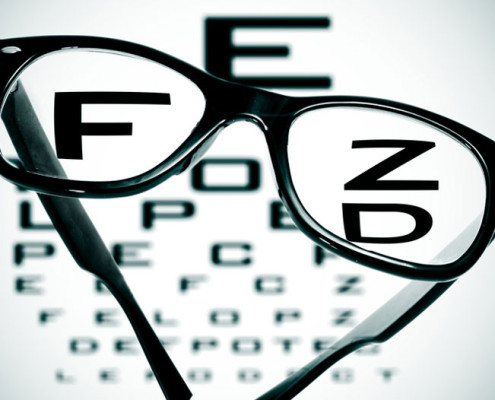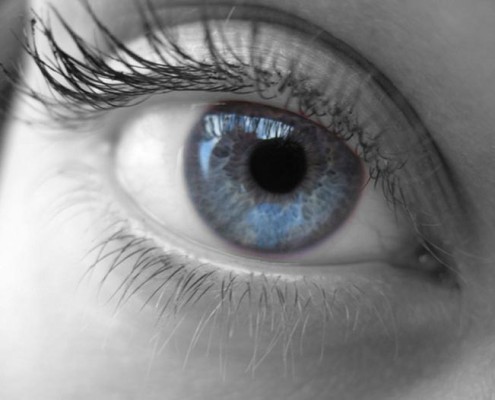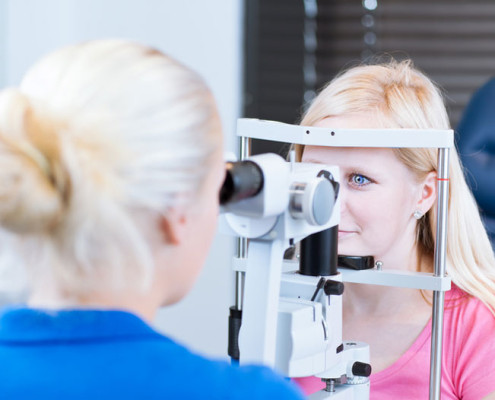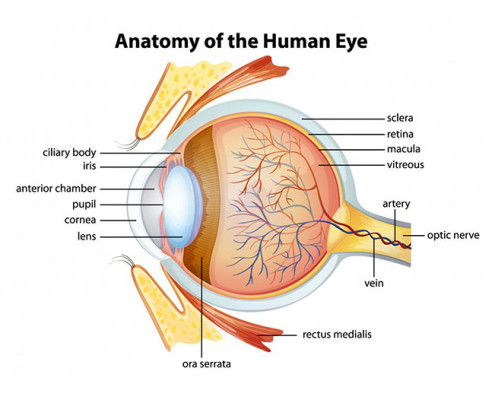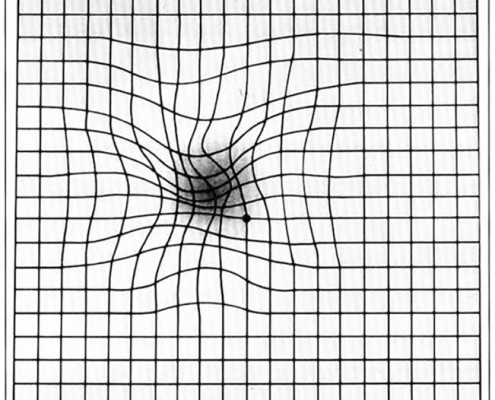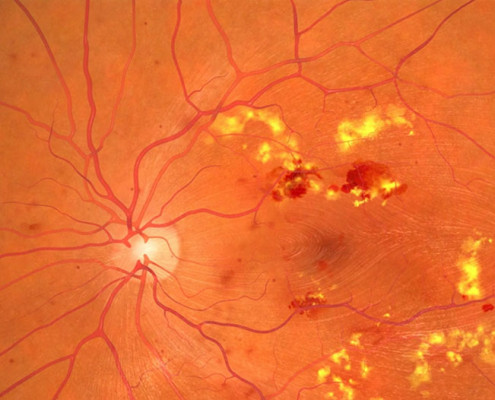EYE CONDITIONS
Please click on a condition to read a brief description and watch an informative video.
Please click on a condition to read a brief description and watch an informative video.
Nearsightedness (myopia) . . . is caused when the light rays focused by the cornea fall in front of the retina. This can be caused by the eye being too long or the cornea being too steep. This results in distant objects being blurry.
Myopia can be corrected in one of three ways: 1) glasses or contact lenses which bend the light rays to focus on the retina; 2) Custom Laser Vision Correction which flattens the surface of the cornea and allows the light rays to focus on the retina; or 3) Cataract removal with lens implantation, which refocuses the light onto the retina.
Farsightedness (hyperopia) . . . is caused when the light rays focused by the cornea fall behind the retina. This can be caused by the eye being too short or the cornea being too flat. In younger individuals, low levels of hyperopia often go unnoticed. However, as we age, hyperopia affects close-up vision first, followed by a loss of distance vision.
Hyperopia can also be corrected in one of three ways: 1) glasses or contact lenses which bend the light rays to focus on the retina; 2) Custom Laser Vision Correction which steepens the surface of the cornea and allows the light rays to focus on the retina; or 3) Cataract removal with lens implantation, which refocuses the light onto the retina.
Click here to learn more about how Custom Laser Vision Correction can eliminate your Nearsightedness or Farsightedness and bring your world into focus without glasses or contacts.
By now, almost everyone is aware that treatments exist to correct your nearsightedness or farsightedness, and reduce or eliminate your need for glasses to see in the distance. Chances are, several of your friends or family members are experiencing the joys of living without glasses or contact lenses as a result of laser vision correction. You’ve heard the excitement in their voices, noticed the boost in their confidence levels, and watched the quality of their lives improved with newfound freedoms.
Millions of Americans are enjoying these life-enhancing benefits, and millions more, just like you, are exploring the procedure that could free them from the worries of glasses and contact lenses. Thanks to a revolutionary breakthrough in technology, now is the time for you to join millions of other happy patients making the dream of clear vision become a reality.
Until now, your treatment was based on diagnostic technology similar to that used for the prescription of eye glasses or contact lenses. However, with Visionary Eyecare & Surgery’s addition of the CustomVue WaveScan (TM) System by VISX, we can produce a precise and more detailed analysis of your vision, and provide you with a more personalized approach to laser vision correction.
With the diagnostic and treatment technologies of the WaveScan System, Dr. Bias can develop a personalized laser vision correction plan that addresses your individual needs.
There are two parts to the VISX WaveScan System. First, it includes a diagnostic device that maps the entire optical path of your eye. This WavePrint (TM) Map, called the “fingerprint of your vision,” provides the surgeon with precise and detailed information about your vision.
Secondly, the WaveScan System incorporates the STAR S4 (TM) laser from VISX with two exclusive features: Variable Spot Scanning (TM) and 3D ActiveTrak (TM) technology. Variable Spot Scanning (VSS (TM)) allows for a larger treatment area and offers the physician greater flexibility in developing a more personalized laser vision procedure, when pupil size may be a consideration.
3D ActiveTrak automatically and instantaneously tracks the minute movements of your eye in all three dimensions during the laser treatment. This unique feature means you no longer have to hold your eye perfectly still, but can relax, knowing your treatment is precisely centered on your eye. The doctor uses these exclusive technologies along with the WavePrint Map to provide laser vision correction care based on your personal vision needs.
We’d love to discuss these new advances in customized laser vision correction with you at your convenience. Call Visionary Eyecare & Surgery today for your personal consultation, the first step to a clearer tomorrow!
Astigmatism is caused when the light rays focused by two different areas of the cornea do not focus at the same spot. The astigmatic eye has a cornea which is shaped more like a football than a basketball. This causes blurring of images at all distances.
Click here to learn how your astigmatism can be corrected in conjunction with your cataract surgery.
The human eye is best able to focus if the cornea (the front clear window of the eye) is round like a basketball. Astigmatism occurs when the cornea has an oval shape like a football. This causes light rays entering the eye to be focused at more than one point on the retina, causing a reduction in vision. Many patients suffer some degree of astigmatism and never experience truly clear vision, not knowing what they are missing. Symptoms of astigmatism include: image distortion and shadows, double vision, tilted images, light sensitivity, glare, and tired eyes.
Fortunately, advances in eye surgery have led to techniques that can reduce or eliminate your astigmatism. After careful, detailed measurements of your cornea, micro incisions can be made along the more highly curved, or “steep” portions of the cornea. This allows those areas to flatten out, giving the cornea a more desirable round shape and better vision.
Cataract surgery is the ideal time to correct any astigmatism. The painless micro incisions to treat the astigmatism can be performed at the completion of your cataract procedure. Patients enjoy the convenience of having both procedures simultaneously, and give themselves the best chance of clear vision after surgery.
Cataract surgery alone can correct only nearsightedness or farsightedness, but not astigmatism. Thus patients may not truly experience their full visual potential if the astigmatism is not also corrected.
First and foremost, by reducing or eliminating your astigmatism at the time of cataract surgery, you improve your chances of not needing any glasses for distance vision after surgery. If you do need glasses, they will be lighter and thinner than before surgery, and often less expensive. You also may experience greater visual comfort, as glare, image distortion, and eye strain are reduced. While no procedure is perfect, Dr. Bias has years of experience in successfully treating astigmatism at the time of cataract removal. Patients should remember they will typically still need reading glasses after their cataract removal, whether or not the astigmatism was treated.
Unfortunately, Medicare and most other major insurance carriers do not cover “refractive” services. This is why you must make a separate payment for your glasses check at the time of your examination. Keeping with this policy, astigmatism treatment at the time of cataract surgery is also typically not covered.
However, as the leader in cataract care in the St. Louis area, Visionary Eyecare & Surgery is pleased to offer this valuable service for a small additional fee. Because the measurements can be obtained during your pre-operative evaluation, and the procedure is carried out in conjunction with your cataract surgery, we are able to pass these savings on to you. And all for a fraction of the cost of traditional laser vision correction procedures.
Better vision at distance without glasses, save money on glasses after surgery, and an improved quality of life – all with a painless, low risk, economical procedure – but only at the time of your cataract surgery!
Presbyopia is an age-related condition. In this condition, the internal natural lens of the eye, which allows us to focus both up-close and at a distance, becomes less flexible and causes problems with near vision. This condition manifests itself in most adults between the ages of 40 to 50 years old, and is exacerbated by underlying farsightedness.
A cataract is a clouding of the lens of the eye, which is normally clear and transparent. When a cataract develops, the lens becomes foggy like a frosted window. There are many misconceptions about cataracts. They are not tumors, or a new growth of skin or tissue over the eye. They don’t spread from eye to eye, and they’re not caused by using your eyes too much. In fact, no one knows what causes cataracts, or how to prevent them. They usually develop gradually over a period of years, and are considered a normal part of the aging process. Most of us, if we live long enough, will develop cataracts.
Glaucoma, one of the leading causes of blindness, is estimated to affect 1 of every 50 adults. Although glaucoma can occur at any age, the risk of developing the disease increases dramatically after the age of 35. Glaucoma is also more likely to develop in persons who are severely nearsighted, persons with a family history of the condition, diabetics and blacks. Because the symptoms of early glaucoma are so slight, the disease often goes unnoticed until permanent vision loss has occurred. However, with early diagnosis and careful treatment, visual damage from glaucoma can be prevented.
Macular Degeneration is the leading cause of impaired reading or detailed vision. It is caused by the breakdown of the macula, the central portion of the retina. Although macular degeneration causes distortion of central and color vision, side vision is not affected. There are two forms of Macular Degeneration, “dry” and “wet”.
Diabetic retinopathy is a complication of diabetes mellitus which causes abnormalities in the tiny blood vessels nourishing the retina. Damage to these vessels causes them to leak fluid and blood, which ultimately damages the retina. Left untreated, diabetic retinopathy can result in severe visual loss, including blindness.

